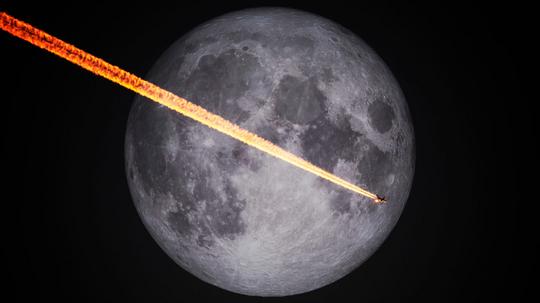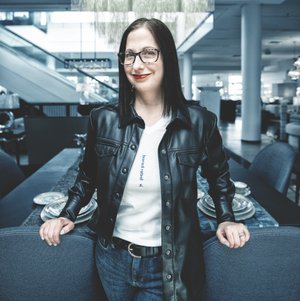
Through digital media, events, data and more, American Inno is building the largest network of local innovation, cultivating engaged startup, tech and entrepreneurial communities in 12 (and counting) markets across the country. As a part of an ongoing series, Inno’s writers will collectively select an industry or theme and highlight a local startup operating in the space.
Fifty years ago, humans first landed on the moon. It was an understandably momentous occasion for mankind.
The spirit of the achievement — of doing the seemingly impossible, and changing the world forever — is still alive. In fact, startups, entrepreneurs and other organizations are working to "shoot for the moon" in their own industries and niches, whether it be by curing cancer, traveling across the planet faster than ever before or ensuring that Mother Nature stays at bay.
So, to celebrate both the moon landing and the innovators who work to drive momentous change for the better every day since, we examined more than 13 "moonshot" companies across Inno's 13 markets. Below, we've rounded up a sampling of each.
To browse all the Inno moonshot pieces in one place, click here.
MADISON // ATLANTA INNO
Some of the worst news a doctor can deliver to a cancer patient post-operation is, “We didn’t get all of the cancer.”
Now, imagine a future where those words were never uttered again. Seems impossible for this day and age, right?
The scientists, leaders and investors of Dune Medical Devices don’t think so, and they’re working towards eradicating the need for more than one operation to remove cancer from the body—a feat more than 20 companies have been unable to accomplish in the past two decades.
The startup, which was founded in Israel in 2004 and later moved its operations to Atlanta, was founded by Dan Hashimshony, who discovered how to differentiate healthy tissue from cancerous tissue using physics and an algorithm. Using the algorithm, Hashimshony developed a pen-like probe that could determine if tissue was cancerous during surgery.
“At the time, what they realized was that while certainly it can work in all solid organ tumors, where it has the most use was in the breast, only because … that was the biggest need at the time,” Dune Medical Devices CEO Lori Chmura said. “And still today, really we’re the only technology that has been able to address this problem.”
Read more here.
https://youtu.be/BSbynmTcAYk
BRENT // AUSTIN INNO
We’ve been waiting on flying cars for decades. But only recently have we gotten a glimpse of what a personal flying car might look like — and feel like. Austin-based Lift Aircraft is one of a growing list of companies hoping to bring air taxis to market. For now, the company, led by uShip founder Matt Chasen, is getting people used to the idea of the flying car with test flights in Central Texas. And this year it’s branching out to 25 other cities with its flying experiences.
Its Hexa aircraft can fly for 15 minutes, while retaining 25 percent battery power as a precaution. Its speed is currently limited to 63 MPH, but it can go faster if you’ve got the skills.
Since we’ve been dreaming about — and trying to develop — flying personal aircraft for decades, Lift is inherently a moonshot. And it faces significant competition from other engineers at Airbus, Boeing and beyond working on personal aircraft. And, then, every company faces regulatory hurdles, as well as logistical ones, that come along with putting more aircraft safely in the sky.
Lift is making its mark by actually getting people up in the air, while many competitors continue testing for broader rollouts.
“Multi-seat eVTOL air taxis, especially those that are designed to transition to wing-borne flight, are probably 10 years away and will require new regulations and significant advances in battery technology to be practical and safe,” Chasen said in a statement. “We didn’t want to wait for major technology or regulatory breakthroughs to start flying.”
Read more here.
Rowan AND SRI // BOSTINNO
The idea first came as an afterthought to Michael Johnson while he was working on an oil spill response team in the Arctic. Now, it’s a fully fledged startup: Sea Machines, a maker of software for autonomous boats operating out of an East Boston shipyard. Johnson, the CEO and founder, was convinced the software was crucial for the maritime industry when he worked on a salvage mission for the sunken cruise ship Costa Concordia.
Sea Machine’s flagship autonomous control system allows autonomous boats to move by waypoint, change course when necessary to avoid collisions and follow other vessels. The latter is the system’s main use for the company’s first customers, which include a “major oil spill response company,” according to Johnson. The startup is also working on a system that uses Lidar, a key sensor for self-driving cars that uses a pulsing laser light to measure distances to surrounding targets, to equip boats with the ability to dock themselves. Sea Machines closed a $10 million Series A round in December 2018.
Read more here.
Courtney // CHARLOTTE INNO
Entrepreneurs are, by nature, a mostly optimistic bunch. They believe so passionately about the dreams that they are building and how they can impact the world we are living in — no matter how big the goal is.
One of the founders who truly embodies this attitude is Stratifyd founder and CEO Derek Wang. His company dubs itself “the best choice in consumer analytics,” and his vision for what he wants the organization to achieve is nothing less than extraordinary: “to democratize AI,” he told Charlotte Inno.
The mission began for Wang when he served as the associate director of the Charlotte Visualization Center at UNCC.
“Primarily, we worked with the U.S. government and the State Department, the DoD and SOCOM, trying to leverage advanced data analytics to perform predictive analytics,” he said.
That meant utilizing publicly available data — think a combo of news and social media, cable wires, etc. — to pinpoint where, say, an epidemic will occur.
The work was received well, with feedback from bank and company leaders boiling down to, “any way we can leverage your research and knowledge [is helpful].” The consensus? That turning human-generated data into actionable insight was a headache companies were struggling to cure.
It was this insight that ultimately inspired Wang to build the startup, which was officially born in January 2015.
Read more here.

Jim // CHICAGO INNO
Perhaps no Chicago tech entrepreneur knows moonshots better than Chris Gladwin. Gladwin is a bonafide serial moonshot founder — having built companies like Music Now, a pioneer in the digital music space that launched a full five years before iTunes, and Cleversafe, a startup that built revolutionary technology around data storage and eventually sold to IBM for more than $1 billion.
His next project is Ocient, a startup that wants to analyze big data. Really big data. As the amount of data the world produces increases rapidly, companies are going to have major challenges making sense of that data. Ocient wants to be that solution not today, but years from now.
“It’s a ‘go extremely big’ or ‘go home’ kind of endeavor,” Glawdin said.
Ocient, founded three years ago, has grown to 50 employees, raised at least $10 million in funding, and is pretty tight-lipped about the rest. Gladwin declined to talk about customers or revenue, but noted that Cleversafe didn’t get its first customer until year six.
“It’s an audacious goal to say we’re going to build the technology that the world’s going to use to analyze all this data,” he said. “Particularly the data we’ll have in the future, which is an incomprehensibly large amount of information.”
Read more here.
AAron // CINCY INNO
While Cincinnati Children’s was neither the first hospital to discover hydroxyurea nor market it, doctors and scientists at the hospital have been testing the drug for numerous years. It’s a treatment option that’s considered a far cheaper alternative to blood transfusions when handling sickle cell disease.
Children’s blood disease expert Dr. Russell Ware led a New England Journal of Medicine-featured study on hydroxyurea earlier this year. After working with children between the ages for 1 to 10 in four sub-Saharan African countries for six months, he found that treatment reduced sickle cell pain by 55 percent, infections by 38 percent, malaria by 51 percent, transfusions by 67 percent and death by 70 percent.
“Hydroxyurea was safe and offered many benefits to these young patients,” Ware said.
Regardless, the new approach has taken awhile to hit the ground running in the U.S. and has taken even longer in Africa. There, the disease is killing many children at young ages due to lack of proper diagnosis and great limitations in treatment.
Ware is working with partners in Africa to help speed up the process of getting hydroxyurea to be adopted as a new treatment. The project aligns with the medical center’s mission, which is to “improve child health and transform delivery of care through fully integrated, globally recognized research, education and innovation.”
Read more here.

NICK // COLORADO INNO
As Centennial’s Boom Supersonic hurtles towards supersonic travel, the company has 50 years of history it’s looking to conquer.
Boom’s founder Blake Scholl always had a passion for aviation, often watching the Cessnas take off and land at his local airport in suburban Cincinnati. From there, he earned his private pilot license in 2008 and instrument rating in 2011.
When he saw the lack of innovation in supersonic travel since the Concorde’s introduction, he wondered what could be done.
“It’s hard to believe that it has been 50 years since a new supersonic commercial airliner was launched. As I contemplated Boom, I realized that the airline industry was one of the rare industries that was stagnating, not advancing,” he said.
In 2014, Scholl began zeroing in on the viability of supersonic travel. To achieve success, he determined that a supersonic aircraft’s fuel consumption would need to gain 30 percent efficiency compared to the Concorde.
When he took these numbers to a Stanford professor that had studied supersonic flight, he realized more could be achieved.
“He thought I was being conservative in my estimates, and that I should try harder, which gave me the confidence I needed to move forward with Boom,” Scholl said.
Since then, Boom has grown exponentially and is on track to take flight with its 2-seat demonstrator plane, the XB-1, in 2020.
Read more here.
KIERAN // DC INNO
Most modern necessities, like cell service, GPS and Wi-Fi, rely on radio frequencies flying around the Blue Planet. But gathering that data efficiently has been close to impossible – until now.
Meet HawkEye 360, a Herndon, Va.-based startup using formation-flying satellites to track Earth-bound radio frequencies around the world.
Just three years after launching, the company has moved from initial financing to spaceflight operations as it looks to disrupt the geolocation industry.
HawkEye was founded in 2015 by Chris DeMay as a spinoff from Boston-based venture creation firm Allied Minds, which licenses and commercializes technology from government and academic labs.
In short, it’s a radio frequency data analytics company. But what does that mean?
HawkEye operates a commercial satellite constellation that locates and identifies a broad set of RF signals coming from the Earth. It runs the data through algorithms, analyzing it along with other sources to offer services like maritime domain awareness and spectrum mapping and monitoring. Those reports are used by governments, shipping companies and military operations to track assets and identify distress signals.
Although RF signals are ubiquitous on the planet’s surface, this is the first commercially available product that can independently locate, process and track many of those signals, according to the company. It provides the coordinates and characteristics of signal emitters, making it more specific and trustworthy than satellite imagery.
Read more here.
MADDY // MINNE INNO
Space is not the final frontier — not if you ask University of Minnesota Associate Professor Dr. Greg Molnar.
“It’s the depths of the ocean, the vastness of space and the mysteries of the brain,” he believes.
Of these three unexplored terrains, Molnar is partial to the brain. He works for the university’s Department of Neurology and serves as director of the Deep Brain Stimulation Research program. Since 2013, Molnar and other scientists have been working together on an ambitious program called MnDRIVE, which aims to bring new and improved therapies to Minnesotans suffering from a wide range of brain conditions.
“There’s a hell of a lot of cool things coming out of MnDRIVE,” Molnar told Minne Inno. “We’re expanding into psychology, spinal cord treatment, sleep disorders, and more. We’re very proud of the work that’s coming out of our corner of Medical Alley.”
Molnar has spent decades translating science into medical device therapies and has numerous patents in the space. Prior to joining MnDRIVE, he was the director of neuromodulation research at Medtronic and led the global research team to advance neuromodulation applications for pain, movement disorders and epilepsy.
Read more here.

Bram // RHODE ISLAND INNO
When a man-made or natural disaster strikes, a lot of chaos can ensue — throwing people into uncertainty and leaving the state tasked with steering the community toward safety.
For Tom Guthlein, executive administrator of the Rhode Island Emergency Management Agency, once his team has first and foremost ensured the safety of the state’s residents and property, the goal is to get back to normalcy as quickly as possible.
And one of the key ways to do this is to get the business community back up and running.
“It’s a partnership, so we are trying to work with the businesses so we know what information they need so we can get it to them,” said Guthlein, adding that 80 percent of the state’s critical infrastructure is privately owned. “We want to get it back to the point where if people need water, they can go buy water from a store instead of us having to stockpile it [and distribute].”
That’s why the state and business community have been taking steps in recent years to better coordinate how they prepare (and act) should a disaster, like a storm or an active shooter situation, take place.
Five years ago, the state completely overhauled its State Emergency Operations Center.
Now, one of the stations in the SEOC is manned by an employee from the Rhode Island Commerce Corporation, a quasi-public agency, so the entire business community essentially has a seat at the SEOC.
“We normally start by sending out a lot of information and do a conference call with important businesses, telling them where impacted areas are so they are aware that this is what we are predicting,” said Guthlein. “We keep them in the loop as we monitor the situation.”
Read more here.
KIERAN // RICHMOND INNO
After taking 3D printing courses in graduate school at Virginia Tech, Elliot McAllister wrote a paper on the potential of using them to design microchips and other small devices. Little did he know, that idea might forever alter the face of medical test development.
For 30 years, little has changed for the people looking to develop new medical tests, especially those including microfluidics. The process involves creating microchips that allow a small amount of fluid in, perform a reaction, and release another fluid — like an at-home pregnancy test or strep throat test.
These “lab-on-a-chip” systems have been used by researchers for decades, but designing such chips takes multiple iterations before producing something patentable. After coming up with the idea, having the design masked and molded at separate labs, and constructing and aligning the small parts by hand, it could take eight weeks and thousands of dollars to run one test.
When McAllister wrote his research paper, there were about 15 DIY kits on the market for 3D printers that had many of the same specs as high-end printers from large companies. But even those couldn’t work at the microscopic level necessary for microfluidics testing.
“We couldn’t do it with 3D printers then, but there was a roadmap to get there,” he said. And related software needed to greatly improve to reach that resolution. “That was my final paper for that class, so I wrote it and sort of forgot about it.”
Several years and startup jobs later, the Blacksburg entrepreneur returned to his thesis and took the plunge to turn it into a company: Skyphos Technologies.
Skyphos developed a 3D-printing process for microfluidics using lab-on-a-chip devices, allowing faster, cheaper testing in hopes of speeding up the process of discovering new technologies.
After self-funding the startup and developing the printing technology, including the physical printer, materials and related software, McAllister graduated in October last year from Roanoke accelerator RAMP with a finished product, pending patents and three customers lined up.
Read more here.
https://youtu.be/uwm3qvFWVRU
LAUREN // TAMPA BAY INNO
Planes, high speed trains and autonomous automobiles are just the beginning for Florida transportation.
But a slow and steady effort has been building for over three years in the Tampa Bay area to bring a new kind of transit tech to the scene: hyperloop.
You may have heard of Hyperloop from Hyperloop 1, the Elon Musk-backed technology in the making that will transport people or goods in a vaccuum-less tube. When the air is removed from the tube, it creates a magnetized levitation where the magnets repel each other, allowing the tube to move even faster. For reference: passengers or cargo could get from Tampa to Orlando in around 10 minutes using the company’s hyperloop technology, which travels at 750 miles per hour.
There are four companies using hyperloop technology, including the aforementioned Hyerloop 1. However, Tampanians are focusing on bringing Culver City, Calif.- based Hyperloop Transportation Technologies, or HTT, to the Bay area.
HTT stands out by using crowdfunding to support its projects. The company licenses the hyperloop tech, which is then made possible through third-party feasibility studies and operators who will carry out the project.
Tampa Bay Area Regional Transit Authority will give HTT its best shot at its latest feasibility study. TBARTA received a record $2.5 million from Gov. Ron DeSantis in June. $1 million of the funding will be solely allocated for feasibility studies.
“This appropriation will allow TBARTA to move the agency and our region forward, hire the appropriate staff needed to execute their mission as set forth by the Florida Legislature and to invest the resources into innovative transit projects,” said Florida State Rep. Jackie Toledo, R-Tampa, said in a statement.
Read more here.

Katherine // WISCONSIN INNO
If you’ve ever played the Sims, taking one glance at the virtual customer assistants made by idAvatars will remind you of characters in the game. They’re very detailed — with different hairstyles, skin tones and features. They’re rocking their own unique personalities and to some degree, have a mind of their own.
idAvatars, founded in 2013 in Mequon, is in the business of creating virtual customer assistants for companies that engage in conversations with their customers online. Made with artificial intelligence, idAvatars is able to give specific personalities and character traits to the virtual assistants that match the identity of the company they represent.
The startup, which raised nearly $3 million in venture capital, focuses on building its avatars with human behavior as opposed to the robotic persona that chatbots often possess. idAvatar’s Founder Norrie Daroga imagines that in the future, each company will have their own idAvatar that consumers will recognize and seamlessly associate with particular companies, sort of like a mascot, but one that is completely digital and can assist with complex problems.
“Everybody told me I had been watching too many Hollywood movies and that it wasn’t possible,” Daroga said. “But technology has certainly improved and become much more commonplace with Alexa and Google Voice…so people are used to talking to [robots]. The difference is that our company puts a face to the voice.
Daroga said idAvatars are ideal for businesses across a variety of industries, including health care, real estate, finance and insurance. The tool can help businesses save time by allowing their digital assistants to answer consumers’ most basic questions, while they get back to the more complicated work. So far, the startup has created avatars for about 20 companies, such as United Healthcare, Guardian Life Insurance and Keller Williams Realty.
“It’s a very powerful branding tool,” Daroga said. “That’s why you have to design it well and figure out the little touches that make the personality shine through.”
Read more here.







